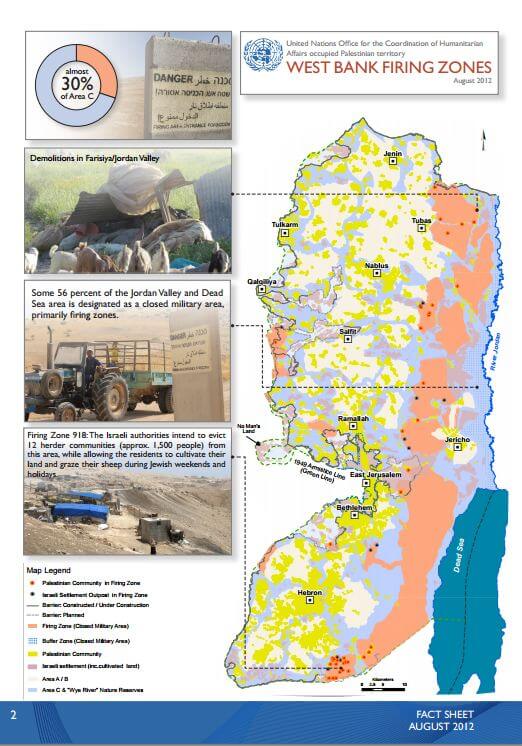United Nations Factsheet on Israeli-declared ‘Firing Zones’ in the West Bank
 In their latest report on the impact of the occupation on Area C communities, the United Nations Office for the Coordination of Humanitarian Affairs has stated:
In their latest report on the impact of the occupation on Area C communities, the United Nations Office for the Coordination of Humanitarian Affairs has stated:
“Approximately 5,000 Palestinians reside in the firing zones, (in 38 communities), mostly Bedouin or herding communities, many of which existed prior to the closing of the area. Over 80% of the communities are located in the Jordan Valley and Dead Sea area or south Hebron
The full report, titled “THE HUMANITARIAN IMPACT OF ISRAELI-DECLARED “FIRING ZONES” IN THE WEST BANK: AUGUST 2012” states:
- Approximately 18% of the West Bank has been designated as a closed military zone for training, or “firing zone”; this is roughly the same amount of the West Bank under full Palestinian authority (Area A, 17.7%).
- Approximately 5,000 Palestinians reside in the firing zones, (in 38 communities), mostly Bedouin or herding communities, many of which existed prior to the closing of the area.
- Over 80% of the communities are located in the Jordan Valley and Dead Sea area or south Hebron hills.
- Over 90% of the communities are water scarce, accessing less than 60 litres per capita per day (l/c/d), compared to the 100 l/c/d recommended by the World Health Organization; over half access less than 30 l/c/d.
- Food insecurity in Area C reaches 24% and rises to 34% among herders, many of whom live in firing zones.
- Two schools and one kindergarten located in firing zones currently have demolition orders against them.
- Some 45% of demolitions of Palestinian-owned structures in Area C since 2010 have occurred in firing zones, displacing over 820 Palestinian civilians.
- There are 10 Israeli settlement outposts located either partially or completely in firing zones.
- In the 1970s, Israel declared large swathes of the West Bank as “firing zones”, which are distinct from other closed military areas, such as those declared around Israeli settlements and between the Barrier and the Green Line. A Palestinian presence is formally prohibited in these zones without permission from the Israeli authorities, which is rarely granted. These declarations have had a serious humanitarian impact on Palestinian civilians and dramatically reduced the land available to them for residential and livelihood uses.
- The firing zones, the boundaries of which are not clearly marked on the ground, have remained largely the same since their establishment, despite significant changes to the security situation. Many residents report that there is little or no military training in their areas.
- Firing zone residents are among the most vulnerable in the West Bank, with high levels of humanitarian need. Most residents have limited or difficult access to services (such as education and health) and no service infrastructure (including water, sanitation and electricity infrastructure).
- The Israeli authorities regularly carry out demolitions in these communities, either in the context of demolition orders or when executing eviction orders. Many of the communities have sustained multiple waves of destruction. Israeli settlement outposts established in the firing zones do not normally face demolitions of their structures.
- Most of the families residing in or near the firing zones are herders, who rely on grazing land for their livelihood. They routinely face restrictions on grazing livestock in these areas and are subject to substantial fines and/or imprisonment. Reduced access to grazing areas has resulted in increased dependency on fodder and the overgrazing of some areas, both of which contribute to diminished livelihoods.
- Residents of firing zones face a range of other difficulties including the confiscation of property, settler violence, harassment by soldiers, access and movement restrictions and/or water scarcity. Combined, these conditions contribute to a coercive environment that creates pressure on Palestinian communities to leave these areas.
- Israel, as an occupying power, has an obligation to protect Palestinian civilians and to administer the territory in a manner that ensures their welfare and basic needs. If restrictive measures respect basic civilian rights and meet a proportionality test, the humanitarian situation can be improved. International law also prohibits the destruction or confiscation of private or public property, unless for reasons of military necessity, as well as the forced displacement or transfer of civilians.


